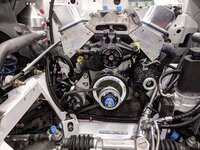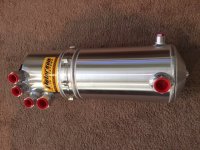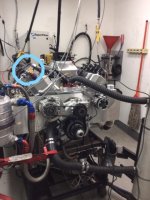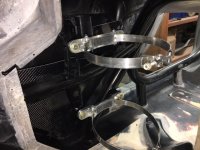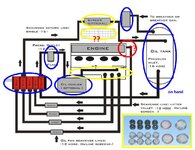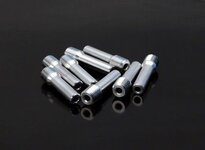phantomjock
Well-known member
I am getting restarted on a number of projects on "Elvira." This thread is focused on Lubrication.
She will be a full-time track-day/racer (occasional drive to AX site-so street legal). Concerned about high-G loss of oil pressure on track, I am considering a Dry Sump setup and need some pointers. I find limited discussion here. I note "back in the day" TT had some comments over on DC as did redvetrcr.
I'm looking to get some intel and help in what I should be considering. Hopefully some members here have done this and can provide guidance.
I found Aviaid https://aviaid.com/pdfs/064-wet_sump_and_dry_sump_oil_pans_for_SMALL_block_chevrolet_engines.pdf has a pretty good summary of bits and pieces - and price$. Also Jones Racing Products has a lot of gear that works on serpentine setups. I'm looking for preferences or recommendations.
Relevant items I currently have installed on my 383 SBC:
Grumpyvette has some good info on his site,
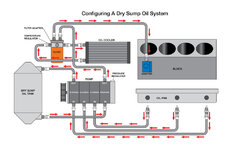
several images that clarify the function of windage trays, and a good schematic of Dry Sump flows, but I need some more specific ideas.
Like:
1. How many stages for the pump? 2, 3,4 - or 5? More stages is more $$, but if I save an engine it would be insurance. Minimum size for race configuration?
2. More stages gets more complex dry sump pan. Clearly the pan needs the same number of ports as the pump. Any specific pan recommendations? Also, I note in Grumpyvette's diagram, the return line is to the block and not the pan. Is there a preference?
3. I'm considering placing the storage/sump tank in the footwell of the passenger side. Good/bad idea?
4. What is the pre-start process? Complicated, or spin the pump to circulate the oil? [I'm in FL not Fargo! Would I need a tank heater on the tank?] Or start the engine and let it idle for 10 minutes until temp/pressure are reached? Or would a charged accumulator resolve any pre-start issues?
Or am I over thinking this--Just buy a kit and bolt it all on?
I've seen a few YT videos and looked for DIY dry sump setups - but no luck. Any links would be much appreciated.
Thanks In Advance.
Cheers - Jim
She will be a full-time track-day/racer (occasional drive to AX site-so street legal). Concerned about high-G loss of oil pressure on track, I am considering a Dry Sump setup and need some pointers. I find limited discussion here. I note "back in the day" TT had some comments over on DC as did redvetrcr.
I'm looking to get some intel and help in what I should be considering. Hopefully some members here have done this and can provide guidance.
I found Aviaid https://aviaid.com/pdfs/064-wet_sump_and_dry_sump_oil_pans_for_SMALL_block_chevrolet_engines.pdf has a pretty good summary of bits and pieces - and price$. Also Jones Racing Products has a lot of gear that works on serpentine setups. I'm looking for preferences or recommendations.
Relevant items I currently have installed on my 383 SBC:
Canton Road Race Pan with big kick outs -- That would be replaced -- I note AL pans can be problematic with damage. So it might have to be steel/stainless steel.
New Mehling Oil pump - guess that comes out too
Remote Oil filter mount - keep that
MasterLube Oil Accumulator - not installed yet - but keep?
Seperate oil cooler and fan setup.
Steering will not be a problem as I'm moving to a front steer setup.
MOUNTING PUMP I'll be running the steering in manual mode - so the KRC pump comes off. No aircon either - reasonable mounting options - or is lower better? My motor is mounted with motor plates not engine mounts so I will no doubt factor that in.
New Mehling Oil pump - guess that comes out too
Remote Oil filter mount - keep that
MasterLube Oil Accumulator - not installed yet - but keep?
Seperate oil cooler and fan setup.
Steering will not be a problem as I'm moving to a front steer setup.
MOUNTING PUMP I'll be running the steering in manual mode - so the KRC pump comes off. No aircon either - reasonable mounting options - or is lower better? My motor is mounted with motor plates not engine mounts so I will no doubt factor that in.
Grumpyvette has some good info on his site,

several images that clarify the function of windage trays, and a good schematic of Dry Sump flows, but I need some more specific ideas.
Like:
1. How many stages for the pump? 2, 3,4 - or 5? More stages is more $$, but if I save an engine it would be insurance. Minimum size for race configuration?
2. More stages gets more complex dry sump pan. Clearly the pan needs the same number of ports as the pump. Any specific pan recommendations? Also, I note in Grumpyvette's diagram, the return line is to the block and not the pan. Is there a preference?
3. I'm considering placing the storage/sump tank in the footwell of the passenger side. Good/bad idea?
4. What is the pre-start process? Complicated, or spin the pump to circulate the oil? [I'm in FL not Fargo! Would I need a tank heater on the tank?] Or start the engine and let it idle for 10 minutes until temp/pressure are reached? Or would a charged accumulator resolve any pre-start issues?
Or am I over thinking this--Just buy a kit and bolt it all on?
I've seen a few YT videos and looked for DIY dry sump setups - but no luck. Any links would be much appreciated.
Thanks In Advance.
Cheers - Jim

